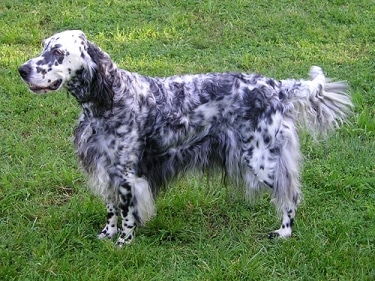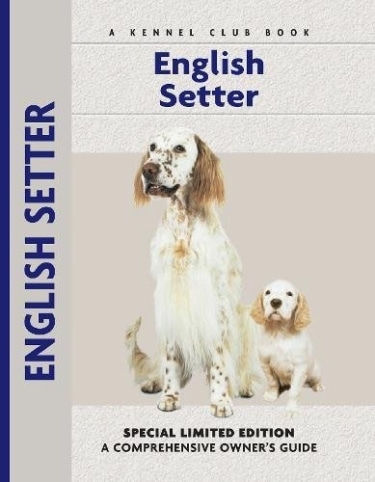
The English Setter is a large, gundog breed with a natural bird instinct. These graceful and friendly dogs are of two types: show and field. Show dogs have a silky, flowing coat while the field dog’s coat is shorter. Overall, the field type is also a bit smaller.
The origins of Setters date back to the 1500s in France and were the result of crossing Spanish and French pointers. Today’s Setters are believed to be the result of crosses of the large Water Spaniel, Spring Spaniel and the Spanish Pointer.
Edward Laverack and R.L. Purcel Llewellin both play a significant role in the development of the present day English Setter. In about 1825, Laverack obtained and mated two Setters “Ponto” and “Old Moll” from Rev. A. Harrison who had kept the breed pure for over 35 years. “Laverack Setters” were specifically recognized for their beauty and refinement and are the base of today’s show dogs. The first show for the English Setter was held at Newcastle-on-Tyne in 1859.
Years later, Llewellin developed from Laverack’s best dogs, a type with excellent field abilities. It is this strain which became the foundation of today’s field type – and is also referred to as “Llewellin Setters”. The Carnegie Museum of Pittsburgh has a statue of the field-trial setter “Count Noble” on display. While there are two different types of English Setters and they can vary in appearance, these dogs are of one breed.
The American Kennel Club recognized the English Setter breed in the Sporting Group in 1884.
Height: The height for a English Setter dog is 24-27 inches (61-69cm) and females 23-26 inches (58-66cm)
Weight: The weight for a English Setter dog is 55-80 pounds (25-36kg) and females 45-70 pounds (20-32kg)
Coat Type: The English Setter’s coat is fine, flat, medium or long length (depending upon the type). Feathering on the ears, tail, legs and stomach. Regular brushing and combing will keep the coat in good condition and bathing needed only when necessary. The English Setter is an average shedder.
Color: The English Setter’s coat can have various speckled colors which are known as belton. Combinations are white with black (blue belton), white with orange flecks (orange belton), white with orange flecks and lighter nose is lemon belton, white with liver flecks (Liver Belton) or “Tricolor” which is blue or liver belton with Tan markings on the face, chest and legs.
Temperament: The English Setter is a friendly, intelligent and gentle breed. These dogs enjoy attention, do well with children and other dogs. English Setters love being outdoors although they should never be kept as outside dogs. English Setters do well with training, but should never be treated harshly. The field type is more active and can be strong-willed and mischievous. The show type is more laid back.
Health Problems: English Setters are a relatively healthy breed. The following health concerns can affect this breed: hip dysplasia, elbow dysplasia, congenital deafness, and canine hypothyroidism. Setters have few genetic problems but some problems occasionally occur. Cancer is more common in older dogs. Allergies are seen in some lines and include food allergies. These dogs should not be overfed. The average life span of a English Setter is between 10 – 12 years.
Special Interest:
• The Carnegie Museum of Pittsburgh has a statue of the field-trial setter “Count Noble” on display.
• The very first dog registered with the AKC was an English Setter named Adonis in 1878 – this breed was recognized in the AKC Sporting Group in 1884.
Classifications:
AKC: Sporting Group
ANKC: Group 3 – Gundogs
CKC: Group 1 – Sporting
FCI: Group 7 – Section 2 – British and Irish Pointers and Setters
KC: Gundog Group
NZKC: Gundog
UKC: Gun Dog
Kennel.com Recommends English Setter
English Setter
 Kennel.com – Complete Guide to Dogs The Dog Lovers Guide
Kennel.com – Complete Guide to Dogs The Dog Lovers Guide